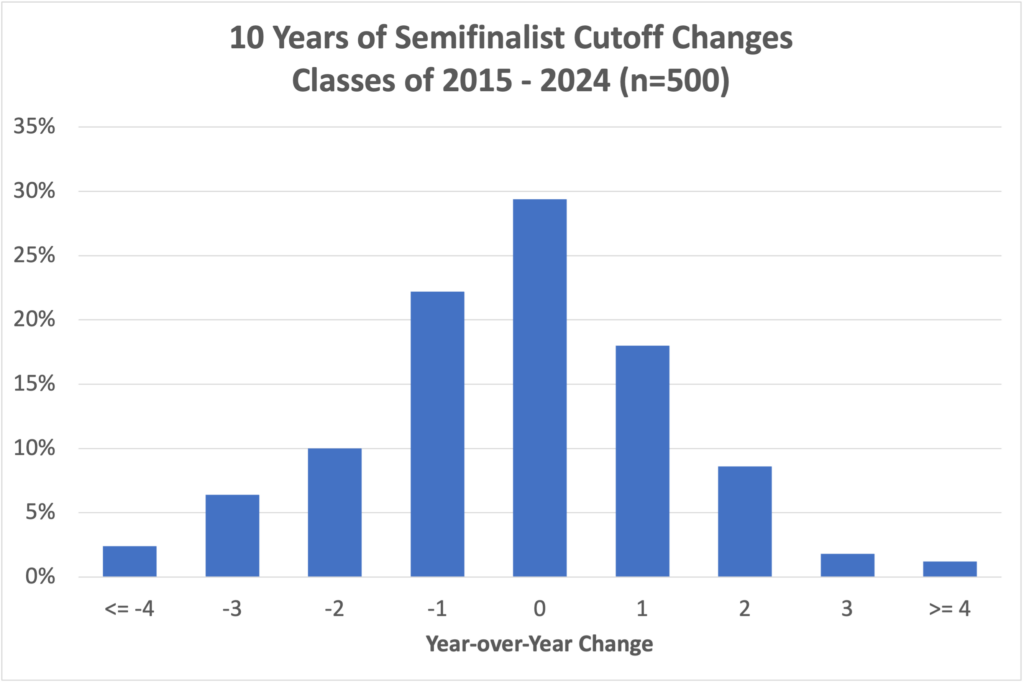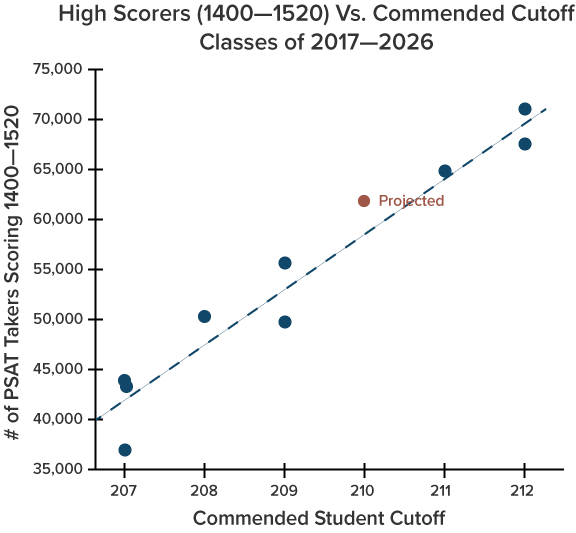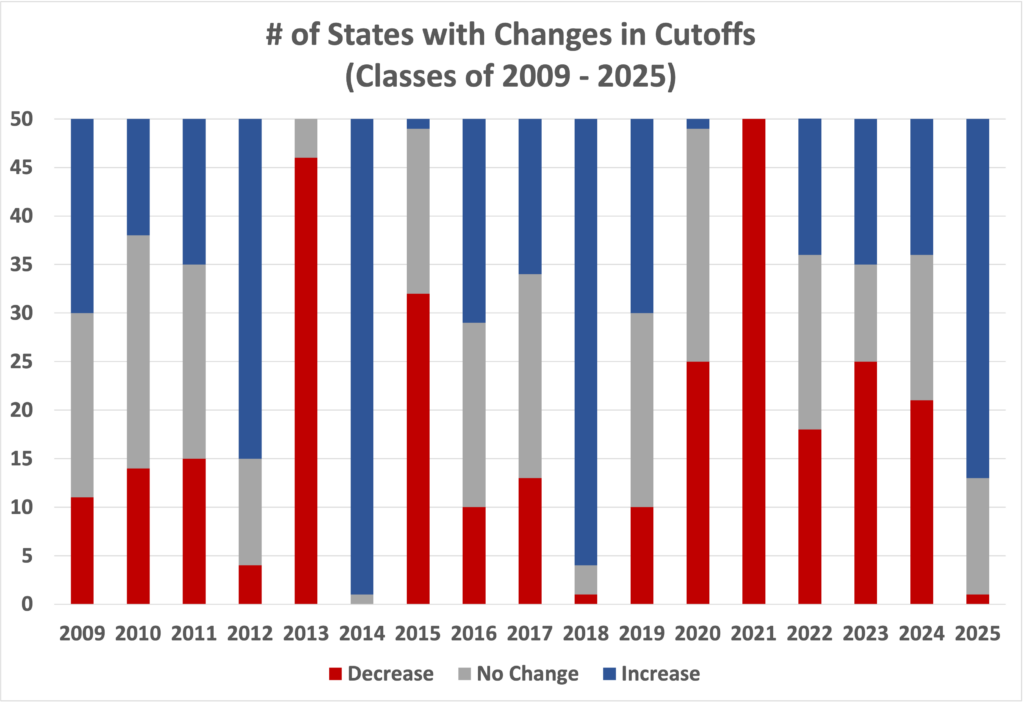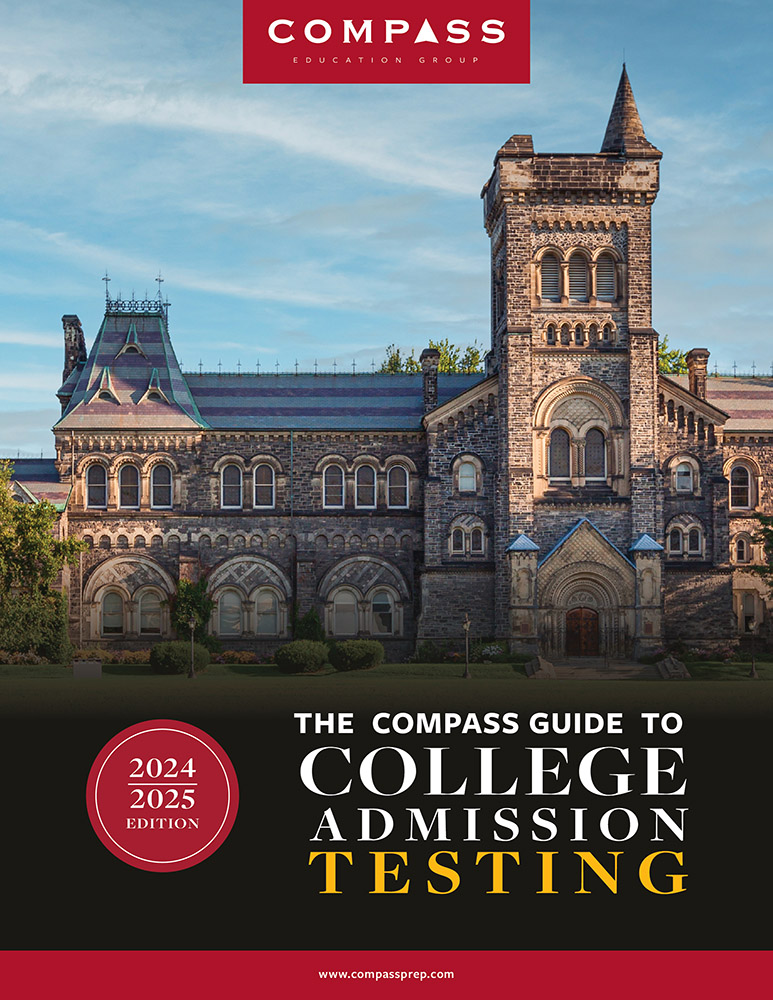
November 13: Updated with final wave of PSAT scores.
College Board released scores in three waves depending on when students took the PSAT. We have now received scores summaries for all three waves. It is possible that some late scores will still dribble in, but we are not expecting any changes. The results point to a strong upward trend in cutoffs for the class of 2026. You are welcome to jump to the table of estimates below, but we encourage students and families to read more about how we came to those estimates. For more information on the National Merit Program, in general, you may want to read Compass’s National Merit Scholarship Program Explained. If you want to browse almost two decades’ worth of cutoffs, you can find them in Compass’s National Merit Historical Cutoffs.
What is a Semifinalist Cutoff?
Each year almost 17,000 juniors are named Semifinalists in the National Merit Scholarship Program and continue on in the hopes of being one of the 15,000 Finalists and, eventually, one of the 7,500 scholarship recipients. The score needed to qualify as a Semifinalist varies by state and is known as the “cutoff.” Every student scoring at or above the Semifinalist cutoff qualifies. The cutoff is not based on a student’s overall PSAT score but on the Selection Index. The Selection Index is listed on a student’s PSAT score report. It can be calculated by doubling the ERW score, adding the Math score, and then dividing the sum by 10. For example, a 720 ERW / 730 M would have a Selection Index of (720 x 2 + 730)/10 = 217. For the class of 2025, cutoffs ranged from 208 to 223.
What is a Commended Student Cutoff?
If you performed well on the PSAT but do not qualify as a Semifinalist, you have the opportunity to be named as a Commended Student. Unlike the Semifinalist cutoffs, the Commended cutoff is set nationally. For last year’s class it was 208. Approximately 36,000 students are named Commended Students each year.
Why does Compass believe that we are likely to see cutoffs, as a whole, go up?
College Board releases very little data about score distribution. The number of top scorers is the most critical piece of information that we get this early in the process. While we do not know the number of students scoring at a particular Selection Index, we do know the number of students scoring in the 1400-1520 range, which roughly correlates to Selection Indexes of 210-228. The class of 2026 ranks 4th in the ten years since the PSAT scoring was overhauled, and this year sees the highest ever percentage of top scores. The number of Semifinalists and Commended students are capped, so cutoffs are likely to rise. But not all cutoffs. The numbers we have seen are at the national level and there is always churn at the state level. What we believe, however, is that more cutoffs will go up than down.
There is a good correlation between the 1400-1520 band of students and the Commended Student score. We believe that the Commended cutoff will come in between 209 and 211, with a 210 being most likely. Based on our historical archive of Semifinalist and Commended cutoffs, we believe that the average Semifinalist cutoff will go up this year.
Will I find out my status right away?
No. In fact, students don’t learn of Semifinalist status until September of senior year. Compass tracks data on current year performance and historical records to provides estimates and updates between PSAT score release and the Semifinalist announcements. Last year — the first year of the digital PSAT — saw a noticeable uptick in scores. Only one state — South Dakota — saw a lower cutoff versus the previous year’s. Was this a onetime quirk? Based on early results for the class of 2026, we do not believe that it was. The upward trend — whether due to the new test format, recovery from COVID-era learning loss, or other factors — appears to be continuing.
One mistake students make is thinking that the cutoff for one year will be the same in the next year. Cutoffs change every year, sometimes by as much as 5 or 6 points (granted, that’s unusual). Compass emphasizes an Estimated Range, which is likely to include the ultimate cutoff. Within that range, we do provide our Most Likely. That score represents our best estimate based on the known factors, but there are many unknown factors. Most of our PSAT performance data are for national results. So we can usually peg the Commended cutoff within a point or two. States, however, can move in different directions. More Alaskan students may test this year. Some strong Rhode Island prep schools may have decided to stop offering the PSAT. A COVID outbreak in Montana could mean more students using Alternate Entry and entering the competition using SAT scores. Below is a table that shows how many states in each of the last 17 years saw increases, decreases, or no change. There has never been a year where even half of all state cutoffs remain unchanged.
The chart below divides the 50 states into those that saw increases (blue), those that remained unchanged (gray), and those that saw declines (red).
Historically, a change in cutoff is more likely than not. Over the decade from 2015 – 2024, Semifinalist cutoffs remained unchanged only about one-third of the time.

We believe that a table of results from this class will skew to the right.
Small states have more volatile cutoffs than large states, but there can be surprises across the board. The PSAT had a significant overhaul in scoring in 2017. If we look at the minimum and maximum cutoffs during the 9-year period from then until the class of 2025, we see that the 13 largest states (about 100,000 or more high school graduates) average a 2.8-point differential. New Jersey has a 1-point differential, since its lowest cutoff is 222 and highest is 223. The smallest states (fewer than 30,000 graduates) have a 6.2 point differential. Alaska has been as low as 208 and as high as 217! The medium-sized states average a 5-point difference between minimum and maximum.
Here are Compass’s current estimates for Semifinalist cutoffs for the class of 2026:
State | Class of 2026 Estimated Range | Class of 2026 Most Likely | Class of 2025 (Actual) | Class of 2024 (Actual) | Class of 2023 (Actual) | # of 2025 Semifinalists |
|---|---|---|---|---|---|---|
| Alabama | 210 - 216 | 214 | 212 | 210 | 212 | 267 |
| Alaska | 210 - 216 | 214 | 214 | 209 | 210 | 36 |
| Arizona | 215 - 220 | 218 | 217 | 216 | 214 | 401 |
| Arkansas | 210 - 215 | 213 | 213 | 210 | 210 | 134 |
| California | 220 - 223 | 222 | 221 | 221 | 220 | 2103 |
| Colorado | 216 - 221 | 218 | 218 | 216 | 217 | 272 |
| Connecticut | 220 - 222 | 221 | 221 | 221 | 221 | 177 |
| Delaware | 218 - 221 | 220 | 219 | 219 | 218 | 43 |
| District of Columbia | 222 - 224 | 223 | 223 | 223 | 223 | 47 |
| Florida | 216 - 220 | 218 | 217 | 216 | 216 | 972 |
| Georgia | 217 - 221 | 219 | 218 | 217 | 218 | 624 |
| Hawaii | 215 - 220 | 218 | 217 | 217 | 215 | 74 |
| Idaho | 212 - 217 | 214 | 213 | 211 | 215 | 102 |
| Illinois | 218 - 222 | 220 | 220 | 219 | 219 | 738 |
| Indiana | 214 - 219 | 217 | 217 | 216 | 214 | 304 |
| Iowa | 211 - 217 | 214 | 212 | 210 | 212 | 156 |
| Kansas | 213 - 219 | 216 | 215 | 214 | 214 | 142 |
| Kentucky | 211 - 217 | 214 | 213 | 211 | 212 | 202 |
| Louisiana | 212 - 217 | 215 | 214 | 214 | 213 | 238 |
| Maine | 212 - 217 | 215 | 214 | 213 | 215 | 53 |
| Maryland | 221 - 224 | 222 | 222 | 221 | 222 | 296 |
| Massachusetts | 221 - 224 | 223 | 223 | 222 | 220 | 294 |
| Michigan | 216 - 220 | 218 | 218 | 217 | 218 | 511 |
| Minnesota | 216 - 220 | 218 | 217 | 216 | 216 | 288 |
| Mississippi | 210 - 215 | 213 | 212 | 209 | 210 | 155 |
| Missouri | 214 - 218 | 216 | 215 | 214 | 213 | 276 |
| Montana | 208 - 213 | 210 | 209 | 209 | 207 | 45 |
| Nebraska | 210 - 216 | 213 | 211 | 210 | 212 | 118 |
| Nevada | 211 - 218 | 215 | 214 | 211 | 210 | 162 |
| New Hampshire | 214 - 219 | 217 | 217 | 215 | 213 | 55 |
| New Jersey | 222 - 224 | 223 | 223 | 223 | 223 | 474 |
| New Mexico | 209 - 215 | 212 | 211 | 207 | 208 | 94 |
| New York | 219 - 221 | 220 | 220 | 220 | 219 | 1089 |
| North Carolina | 216 - 220 | 218 | 218 | 217 | 217 | 518 |
| North Dakota | 209 - 213 | 210 | 210 | 207 | 209 | 28 |
| Ohio | 215 - 219 | 217 | 217 | 216 | 216 | 582 |
| Oklahoma | 209 - 215 | 212 | 211 | 208 | 211 | 214 |
| Oregon | 215 - 220 | 217 | 216 | 216 | 216 | 205 |
| Pennsylvania | 217 - 221 | 219 | 219 | 219 | 218 | 583 |
| Rhode Island | 213 - 220 | 217 | 217 | 215 | 216 | 50 |
| South Carolina | 210 - 217 | 215 | 214 | 209 | 213 | 234 |
| South Dakota | 209 - 214 | 211 | 208 | 209 | 212 | 41 |
| Tennessee | 215 - 219 | 218 | 217 | 217 | 215 | 319 |
| Texas | 218 - 221 | 220 | 219 | 219 | 219 | 1714 |
| Utah | 210 - 216 | 213 | 211 | 209 | 211 | 195 |
| Vermont | 211 - 217 | 215 | 215 | 212 | 213 | 33 |
| Virginia | 220 - 223 | 222 | 222 | 219 | 221 | 394 |
| Washington | 220 - 223 | 221 | 222 | 220 | 220 | 358 |
| West Virginia | 209 - 212 | 210 | 209 | 207 | 207 | 66 |
| Wisconsin | 213 - 217 | 215 | 214 | 213 | 213 | 289 |
| Wyoming | 209 - 213 | 211 | 209 | 207 | 207 | 24 |
| U.S. Territories | 209 - 211 | 210 | 208 | 207 | 207 | 45 |
| Studying Abroad | 222 - 224 | 223 | 223 | 223 | 223 | 112 |
| Commended | 209 - 211 | 210 | 208 | 207 | 207 |
If you’d like to see even more historical data, you can find cutoffs going back to 2008 in Compass’s National Merit Historical Cutoffs.
Why does each state have its own Semifinalist cutoff if the program is NATIONAL Merit?
This is always a hot button question. NMSC allocates the approximately 17,000 Semifinalists among states based on the annual number of high school graduates. That way, students across the nation are represented. It also means that there are very different qualifying standards from state to state. A Massachusetts student with a 220 might miss out on being a Semifinalist. If she lived 10 miles away in New Hampshire, she would qualify.
NMSC sets a target number of Semifinalists for a state. For example, California sees about 2,000 Semifinalists every year, Michigan 500, and Wyoming 25. In each state, NMSC determines the Selection Index that comes closest to matching its target number of Semifinalists. If 1,900 California students score 222 and higher and 2,050 score 221 or higher, then the Semifinalist cutoff would be 221 (this assumes that the target is exactly 2,000). Because score levels can get crowded, it is easy for cutoffs to move up or down a point even when there is minimal change in testing behavior or performance.
No Semifinalist cutoff can be lower than the national Commended level. Cutoffs for the District of Columbia and for U.S. students studying abroad are set at the highest state cutoff (typically New Jersey). The cutoff for students in U.S. territories and possessions falls at the Commended level each year. Boarding schools are grouped by region. The cutoff for a given region is the highest state cutoff within the region.
Why does the number of top scorers vary from year to year?
While there are changes in the number of students taking the PSAT/NMSQT, there can also be small flaws in test scaling that play a role. Prior to the digital PSAT, a single test form was seen by a large percentage of test takers. Something amiss with that single form could impact selection cutoffs across the country. The digital PSAT is constructed differently. Students receive unique form codes drawn from a large pool of problems. Scaled scores are generated based on the characteristics of those problems. In theory, this should make scores more stable. College Board’s early studies have found an extremely high correlation between the paper-and-pencil test and digital test. Still, even with its adaptive nature, the uncertainty remains as to whether the much shorter test can reliably score students at the 700-760 end of the scale.
What if I missed the PSAT because of illness or other legitimate reason?
You may still be able to enter the scholarship program by applying for Alternate Entry using an SAT score. Find information about last year’s process in Compass’s explanation of National Merit alternate entry.
When are National Merit Semifinalists announced?
The Commended cutoff becomes unofficially known by the end of April. The lists of Semifinalists are not distributed to high schools until the end of August. NMSC sets a press embargo on Semifinalist announcement until mid-September, but schools are allowed to notify students before that date. NMSC does not send Commended Student letters to high schools until mid-September. Compass will keep students updated on developments as those dates approach.
Do state and national percentiles indicate whether I will be a National Merit Semifinalist?
No! Approximately 1% of test takers qualify as Semifinalists each year, so it is tempting to view a 99th percentile score as indicating a high enough score — especially now that College Board provides students with percentiles by state. There are any number of flaws that rule out using percentiles as a quick way of determining National Merit status.
- Percentiles are based on section scores or total score, not Selection Index
- Percentiles are rounded. There is a large difference, from a National Merit perspective, between the top 0.51% and the top 1.49%
- Percentiles reveal the percentage of students at or below a certain score, but the “at” part is important when NMSC is determining cutoffs.
- The number of Semifinalists is based on the number of high school graduates in a state, not the number of PSAT takers. Percentiles are based on PSAT takers. States have widely varying participation rates.
- Most definitive of all: Percentiles do not reflect the current year’s scores! They are based on the prior 3 years’ performance. They are set even before the test is given. And if you are going to use prior history, why not use the completely accurate record of prior National Merit cutoffs rather than the highly suspect percentiles?
Entry requirements for National Merit versus qualifying for National Merit.
Your PSAT/NMSQT score report tells you whether you meet the eligibility requirements for the NMSP. In general, juniors taking the October PSAT are eligible. If you have an asterisk next to your Selection Index, it means that your answers to the entrance questions have made you ineligible. Your answers are conveniently noted on your score report. If you think there is an error, you will also find instructions on how to contact NMSC. Meeting the eligibility requirements simply means that your score will be considered. Approximately 1.4 million students enter the competition each year. Only about 53,000 students will be named as Commended Students, Semifinalists, Finalists, or Scholars. See National Merit Explained for more information.





My daughter’s 213 qualified her to be a Semifinalist in Alabama.
Congratulations to your daughter, Anon!
Hello Art! You are to be commended for taking the time to update this page and to answer so many questions. Thank you!
Does anyone have more news on Indiana yet? Hoping a 216 makes it!
The report from the 215 qualifier is highly reliable. I think you are safe to celebrate!
I have a 216 in Indiana! Sounds like I should be expecting a notification, is that true? How long until I hear for sure? Thank you!
Michael,
Yes, you should be expecting a notification. The weird thing is that there is no guaranteed notification schedule or date. The notifications tend to pick up after Labor Day as counselors start returning. The letter from NMSC asks schools to not make the information “public” until the press embargo date that is likely to be September 14th this year. Many schools interpret it to mean that they shouldn’t even tell the students. I advocate that it only means that schools should not put the information in the school newspaper or make an announcement at an assembly until after that date.
Since you know that you have qualified, you can either just relax until your school notifies you (my recommendation), or you can follow up with your counselor. Do the latter politely, since you’ll need their support at the Finalist stage.
Art, thanks to you and Compass for being the best source of information for this national merit process.
Any word out of Louisiana? Our son has a 215 and we feel like we are on the bubble. Haven’t heard anything from his school yet.
Thanks!
One of my fellow Compass principals happened to be talking to a Louisiana counselor last night. I’m about to update the site with LA = 213. Congratulations!
My son made 212 (took the test @ freshman year), so in theory, he will qualify when retake the test in junior year. Right?
It would be highly unlikely that he’d drop between freshman and junior year. Good luck to him in October.
Pagination of comments is seemingly broken on this post – have your tech peeps take a look?
Friendly,
Yes, it’s a glitch in the WordPress theme that we use. A simply workaround is to right-click on Older Comments and open in a new tab. It will work after that (i.e. you don’t have to keep opening new tabs if you want to scroll back further).
219 qualified in Illinois! (Thanks Art for this service. It has been so helpful.)
Thank you, Steve!
Thank you for all of this! How certain is the 219 in Illinois? Our school principal said yesterday he had not yet received anything.
Certain.
Any news form the DMV area (DC, MD, VA)? My daughter has a SI = 220 (1590 SAT) and I am bracing for the worst. While I am happy for the semi-finalists with a lower SI from other states, it seems unfair that your state of residency determines whether you qualify for awards semifinalists are eligible for. I understand that this has been going on for a long time. Has this issue been addressed earlier?
Not yet, Anon.
The issue has been addressed probably 40 times over the last 8 years, but it’s a natural reaction. I try to stay neutral on the topic because it is what it is. NMSC would probably give high-minded reasons about how the distribution actually makes it a more national competition. I’d point to the very practical consideration: National Merit wouldn’t exist in its current form without the state cutoffs. National Merit depends on funding from sponsors. If those sponsors felt that most of the awards were going primarily to just a few states, then they wouldn’t be sponsors for long. Nor is this sort of structure unprecedented. Competitions as different as the Little League World Series and Rhodes Scholarships make regional decisions. Geography even comes into play in college admissions.
Your daughter’s 1590 (Congratulations!) will serve her well during the admission process no matter how things shake out in National Merit.
On a related note, why isn’t the raw score used? My daughter got a 1470, with a perfect math score, so 218. Had it been reversed and had she gotten a perfect verbal but also a 1470, she would have a 222 and would qualify. There are two math sections and two verbal. Seems like math oriented kids are unfairly hurt.
AB,
You are correct. It’s been a quirk of the program dating back at least 50 years. Even when there was just a Math score and a Verbal score (not separate reading and writing), NM doubled the verbal. It’s just how they’ve always done it, and I don’t see any chance of it changing.
My son had a 218 in PA. Are you certain that is the cutoff? Don’t want to celebrate too early!
100% certain. And I don’t use 100% lightly.
Are you as certain about the KS cutoff also? My son has 215 and not yet got informed from school but we are excited about the comments here.
UBT,
I’m fairly confident that the information is correct.
Any word on Virginia cutoffs? 221 right now and feel like I’m on the bubble.
Not yet, Em.
Same with my son. C’mon 221!
Is there news for Georgia, my daughter has a 218, which is one point lower than last year’s cut off.
Ginger,
Please check out Facebook page for some positive news! https://www.facebook.com/CompassTestPrep
Thanks Art and the Compass site, always so resourceful and helpful, no more nervous waiting, I appreciate the happy news!!!
Hi Art! I know it will be a while before we know for sure, but what do you think the chances are for a 222 at a northeast boarding school with cutoffs skewing low this year? Thanks!
As long as New Jersey doesn’t get lumped in, I think you are good. I doubt MA will hit 223 this year. NJ is a toss-up. [Boarding school cutoffs are set at the highest state cutoff within a region.]
Unfortunately, I think NJ is in the northeast boarding school region–it’s New England + Mid-Atlantic!
Thanks, Anon. I’m not in a place to research it.
Do you think 225 is safe in NJ? Thanks.
Absolutely!
Any news on CT?
Not yet, John.
Hi Art,
Given what you’ve been seeing/hearing, do you think your most likely prediction of 220 will hold for CT?
Thanks for all your valuable info!
John
There is not enough information yet to speculate on Connecticut. We’ll have to wait a little longer.
Ok. Thanks, Art.
Art,
A student from California posted on Reddit that he/she qualified at 219. My jaw dropped. Can this be true?
Meg, I don’t believe it is true.
really?? i was hoping it was.
There has to be SOME news on NY???? My daughter had a 226 but we are waiting on her best friend who has a 219. Ant thoughts?
For such a big state, New York always seems to lag in terms of updates. Congratulations to your daughter! I think a 219 has a good chance in NY given what we have seen so far.
Do you think that a 215 in Ohio will qualify?
Jon,
I’m not optimistic.
Why is that? I’ve been holding my breath for my son’s 214 and found a little hope in all the low numbers so far
I’ve received unofficial information that a 215 did not qualify, so I think the cutoff will be 216.
Hello Art, Thank you for everything you do for countless Families during a challenging time. We are so grateful to you! Our son scored a 221 in AZ and when I asked you last Dec., you predicted that he should make the NMSF cutoff for 2023.. Will now just patiently wait for the school notification and the extensive Finalist application process. Art, would you happen to have the latest updated data on which universities currently offer the most generous/comprehensive Scholarship packages to those students making it to NMF status? Thanks again. Sincerely, Steve
Steve,
I consider myself an expert on the Semifinalist process, but not on the college scholarship side. I’ve found that the College Confidential forums are helpful, because there are many parents who have been through or are going through the same process.
218 in Oregon…. any chance?
I think you’re in good shape this year.
213 in KY has qualified
Thank you, JK!
Any thoughts on whether IL will drop to 218? Thank you.
Jill,
I think it is likely to hold at 219.
216 in Ohio – how good are the chances??
(By the way, thank you Art for sharing your vast knowledge! Very helpful!)
I’d rank it as my most likely for Ohio.
I’ll use your comment to post the unrelated news that I now have information confirming Alaska at 210 and Arkansas at 210. New York we now know is <= 220.
Hello! Thanks for all your wok on this!
How come the FB page has Georgia with a 218 but you don’t have that listed here? Are you not confident of that number?
I’m confident. This is my vacation week, and there are times where it is much easier to update FB or these comments than it is to address the post. In the event of a disagreement, FB likely has the latest information.
Definitely an = 218 in Georgia? Or a <=218?
My son has a 217 😬
Definitely = 218, I’m afraid. Your son did a great job and will be named a Commended Student.
Hi Art, Thank you so much for everything you do. This is one of the great resources of the internet!
How confident are you of the 221 in California? My daughter has a 221 and we’re holding off the celebration for now!
Your daughter will qualify. She can celebrate now or when she receives the letter from her counselor!
MY SON MADE A 218 (LOUISIANA). DONT KNOW A WHOLE LOT ABOUT THIS BUT WILL HE QUALIFY AS A SEMIFINALIST.. HE ALSO MADE A 34 ON HIS ACT
Your son will qualify as a Semifinalist. Congratulations! The 34 ACT will be high enough to serve as a confirming score — one of the requirements for moving onto the next stage as Finalist. When he receives his letter from his counselor, it will explain what he needs to do to apply for Finalist.
any news on DMV area yet (DC, MD, VA)?
Patty,
I just added to our FB post that Maryland’s cutoff is 222 this year. That’s down 2 points from the Alternate Entry-inflated class of 2022, but it’s still above the 221 lows we have seen in the past.
Hi Art! My daughter is a 222 in MD. Is that cut off certain?
It’s certain. Congratulations to your daughter!
Did a 222 actually make it in Massachusetts?!!?!?? I hope it’s accurate omg
It looks accurate. Tentative congratulations.
Is there any more news from Massachusetts? We are unlikely at 218, but still curious to see how it goes.
Massachusetts’ cutoff came in at 220.
Do you think a 213 will qualify in New Mexico? I have been at the edge of my seat all week but my counselors haven’t heard anything.
Thanks for all of your help in this confusing process!
New Mexico has been on a downward trend recently, so I think you are in good shape with a 213.
Do you think a 212 might have a chance in Oklahoma?
Yes, a 212 is definitely in play.